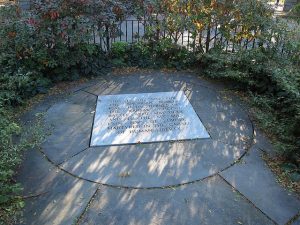Stones abound in Manhattan’s Riverside Park, but none bear the weight of history quite like the one known as der shteyn. The stone. Planted in the landscape in 1947, it marked the future home of a monument to the six million Jews who had perished in what came to be known as the Holocaust.

Fifteen thousand people, among them city officials, high ranking ambassadors and 100 survivors of Buchenwald and Dachau attended the cornerstone-laying ceremony, as did representatives of the 34 different Jewish groups that constituted the monument’s sponsor, the American Memorial to Six Million Jews of Europe, Inc.
The memorial was never built. These days, the compact spot where it was to have been is encircled by an iron fence. Within its precincts lies a granite plaque, its surface worn by time and the weather, which reads: “This is the site for the American memorial to the heroes of the Warsaw Ghetto Battle April-May 1943 and to the six million Jews of Europe martyred in the cause of human liberty.”
Stalled by both financial and aesthetic challenges, the monument’s fate was sealed by New York’s Art Commission which, when asked in 1964 to rule on the appropriateness of two, admittedly oversized, designs, rejected them both.
Some members thought the proposed monument “might distress children in the park.” Others thought it would set a bad precedent, prompting other groups to insist on planting their own memorials on public grounds. And still others insisted that the city’s parks were no place for mourning. “We feel parks are for relaxation and not for the commemoration of massacres,” declared Arnold Whitridge, president of the Art Commission. And that was that.
Or so you’d think. But that would be to discount the will of the people and the process of cultural improvisation by which a tiny plot of land was transformed into a memorial site all its own. Each year, a hundred or so people -- most of them affiliated with the Congress for Jewish Culture, the Jewish Labor Committee, the Workmen’s Circle and the Jewish Labor Committee -- come together in Riverside Park to commemorate the Warsaw Ghetto uprising.
This year, I was among them. At first blush, I was struck by the anomalousness of the entire enterprise. Here we were, a clutch of mourners attending to the sadness of Jewish history as dogs scampered by, kids zoomed along on their scooters and neighborhood residents were out and about on a leisurely Sunday stroll.
But as I settled into my plastic seat and took in the Yiddish that filled the air, it felt right: modest, unassuming and true. We didn’t need a towering monument to remind us that, in the words of the Hymn of the Partisans, which we sang with gusto, mir zaynen doh! We are here.

